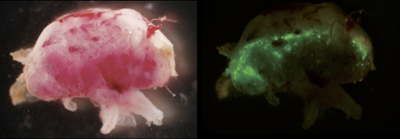| RIKEN Center for Developmental Biology (CDB) 2-2-3 Minatojima minamimachi, Chuo-ku, Kobe 650-0047, Japan |
August 6, 2010 –Not only have genomic techniques shown us the diversity of genetic mechanisms for establishing, maintaining and regulating the body’s functions, they have brought into clear focus the fact that life is not ruled by genetics alone. The study of heritable changes in phenotype independent of the underlying DNA is collectively referred to as epigenetics, and has begun to reveal the intricacy and fundamental importance of such processes as chromatin remodeling and the modification of genomic sequences by various proteins to our understanding of biological processes. DNA methylation is one such modification, in which methyl residues are added to and maintained at specific sites on the genome through the action of methyltransferases. These have been shown to be essential to the growth and survival of somatic cells but, interestingly, not to pluripotent embryonic stem cells (ESCs). The question of whether DNA methylation functions in any type of differentiated cells comes down to their role in extraembryonic tissues, which has never been fully determined.
To address this question, Morito Sakaue, Hiroshi Ohta and colleagues in the Laboratories of Mammalian Epigenetic Studies (Masaki Okano, Team Leader), Genomic Reprogramming, and Pluripotent Stem Cell Studies studied extraembryonic development in mice lacking all three DNA methyltransferases known to have physiological function. In a report published in Current Biology, they show that in these triple knockout (TKO) embryos, while differentiation into the embryo proper was affected, the development of extraembryonic stem cells and tissue was normal. Sakaue and Ohta examined developmental abilities of mouse embryos deficient for active DNA methyltransferases, Dnmt1, Dnmt3a, and Dnmt3b, (TKO) by applying nuclear transfer (NT) technique. No abnormalities were seen in development up to the blastocyst stage even in the absence of three Dnmts. To examine subsequent stages, the team made aggregates of TKO-NT and wildtype embryos (DNMT mutations are known to be lethal to embryos), and found that few mutant cells were detected in the embryo proper, but they contributed to extraembryonic tissues in the chimeras. So, while DNA methylation is not necessary for the earliest differentiation event that separates the extraembryonic tissue from the embryo itself or for further differentiation in the extraembryonic tissues, it is required for cell survival within the embryo. Their next question was, why? On observing the TKO embryos, they saw signs that somatic differentiation had begun to take place, but that the cells did not survive. Sakaue and Ohta used retinoic acid to steer mutant ESCs toward a neuroectodermal fate, and found that, just as in wildtype, the cells expressed the appropriate genetic markers but that they were subject to extensive apoptotic cell death, possibly linked to the DNA damage response. When they turned to the trophectoderm, however, they did not find unusual levels of apoptosis. When they used Gata4 to induce a second extraembryonic lineage, known as primitive endoderm, these too showed no significant differences from wildtype, suggesting that DNA methylation is not required in extraembryonic tissues in the mouse. As a final test of the role of DNA methyltransferases, Ohta and Sakaue made trophectoderm stem (TS) cells from triple knockout blastocysts made by nuclear transfer. They found that, like the differentiated extraembryonic cells, the TS cells showed normal behavior and viability, and could proliferate for dozens of passages in culture. Using genetic inducers, they further showed that these stem cells were capable of differentiating into all of the expected cell types, and even contributing to placenta in vivo. Despite these similarities, however, the mutant TS cells showed differences in gene expression revealed by microarray, suggesting that DNA methylation does have a regulatory function in TS cells. “In somatic cells, epigenetic marks on chromosomes support the stable maintenance of cellular properties over the long term, while cellular properties are reprogrammed during embryogenesis, and are associated with the reorganization of epigenetic marks; that is, cells have “stable” and “flexible” modes in their epigenetic regulation” says Okano. “Mechanisms that tolerate growth without DNA methylation in ES and TS cells may underlie the epigenetic flexibility of these cell types and early embryos.” |
||||
|
||||
 |
| Copyright (C) CENTER FOR DEVELOPMENTAL BIOLOGY All rights reserved. |
